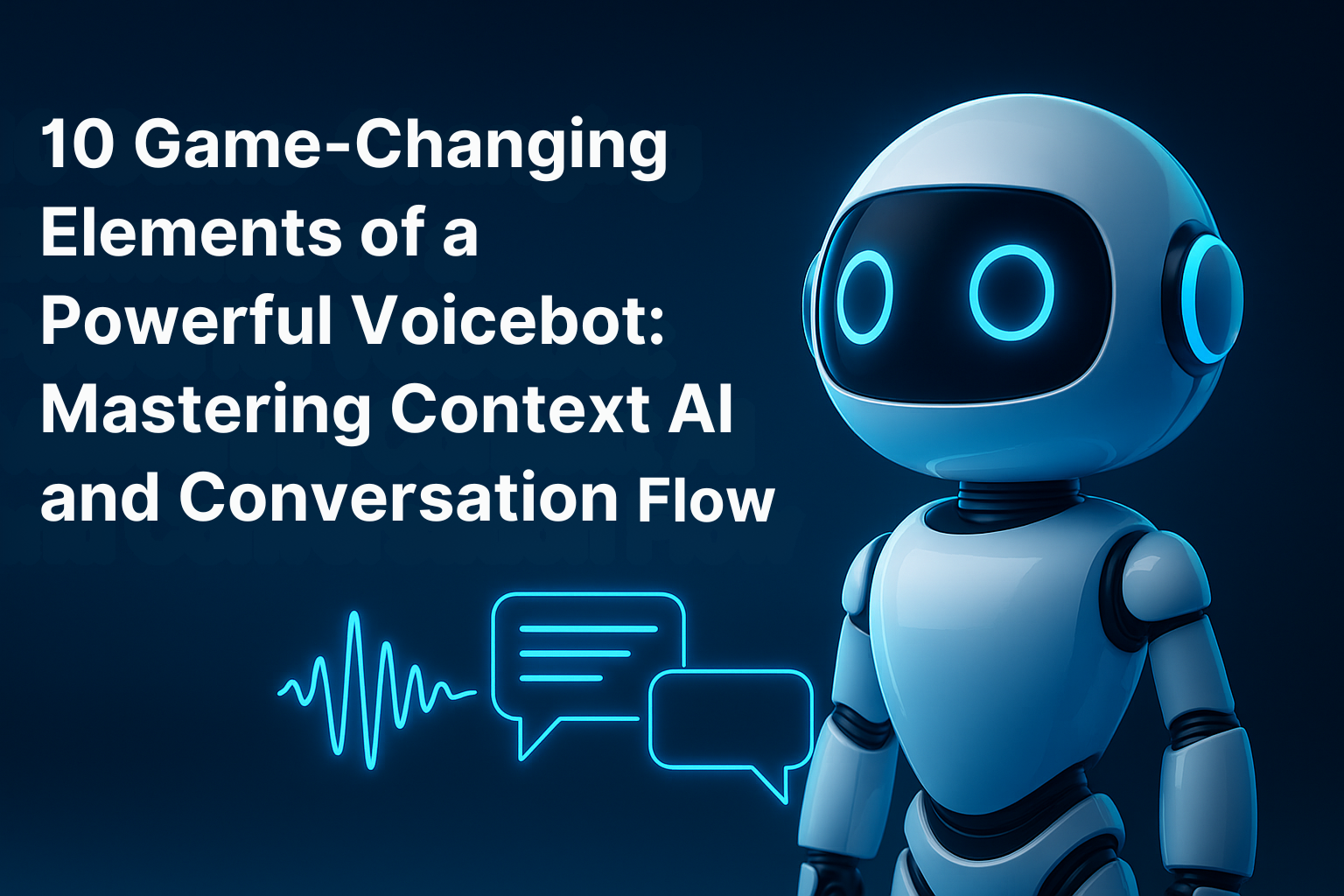
Introduction: The Evolution of Voicebots in the Age of AI
Over the past decade, voice technology has evolved from a novelty to a necessity. Voice-enabled assistants like Alexa, Siri, and Google Assistant have already transformed how we live. But in the enterprise and customer service space, the rise of voicebots marks a deeper shift toward frictionless, AI-driven interactions. With customers expecting instant, personalized service, businesses are now turning to advanced voicebots powered by contextual AI to manage conversations at scale.
The real question is, what separates a basic voicebot from a truly powerful one? The answer lies not just in recognizing voice commands but in mastering context, natural language, flow design, and multi-platform integration. A “good” voicebot today isn’t just smart—it’s adaptive, fast, secure, and human-like in the way it responds.
This article dives deep into the ten most critical factors that define a high-performing voicebot and how these technologies are shaping the future of AI communication.
Understanding the Foundation: What Is a Voicebot?
A voicebot is an artificial intelligence system that allows users to interact with digital services through spoken language. It combines several core technologies including automatic speech recognition (ASR), natural language processing (NLP), and text-to-speech (TTS) to create a seamless voice experience. Unlike traditional IVR systems that offer rigid menus, modern voicebots use AI to understand intent, context, and even emotional tone.
Voicebots are commonly used in customer support, virtual assistance, healthcare appointment systems, e-commerce product searches, and even in-car systems. Their ability to operate 24/7 and handle thousands of calls or interactions simultaneously makes them ideal for businesses seeking scalability without compromising quality.
Contextual AI: The Secret Sauce Behind a Smart Voicebot
Contextual AI refers to the system’s ability to understand the full scope of a conversation—not just the words being spoken, but the intent, history, tone, and environmental variables surrounding them. This is what enables a voicebot to maintain a human-like dialogue that feels natural and intelligent.
Consider a scenario where a customer says, “Cancel my reservation.” Without context, the system might ask for clarification. But a voicebot equipped with contextual AI can look up recent activity, identify the latest reservation, and ask, “Are you referring to your dinner reservation for tonight at 7 PM?” This kind of proactive understanding enhances the user experience and reduces friction.
Contextual AI also allows voicebots to adapt to returning users by recalling past interactions. If a customer previously reported an issue with their delivery, the bot can proactively follow up the next time the user engages, creating a sense of continuity and personalized service.
Natural Language Processing: Enabling Voicebots to Understand and Respond Intelligently
Natural Language Processing (NLP) plays a crucial role in making voicebots smart. It allows the system to break down user input into understandable components, interpret the meaning, and craft appropriate responses. In the past, bots could only handle specific commands like “Play music” or “Check balance.” Today, NLP enables them to process complex sentences, paraphrased requests, and even grammatically incorrect inputs.
Thanks to advances in large language models (LLMs), modern voicebots can now understand nuances such as sarcasm, emotion, and slang. NLP also facilitates language translation, making bots usable in multilingual environments. When combined with sentiment analysis, the bot can adjust its tone depending on whether the user is frustrated, confused, or happy, helping to de-escalate negative interactions or enhance positive ones.
Voice User Experience (UX): Designing Flows That Feel Natural
A great voicebot doesn’t just understand what you say; it knows how to respond in a way that feels conversational. This is where voice UX design comes into play. In contrast to text interfaces, voice interactions must account for auditory processing, pace, and memory load. Users can’t “see” options—they have to remember what the bot said, so clarity and brevity are crucial.
Voice UX involves designing dialogue flows that mimic human conversation. This includes managing turn-taking, interruptions, clarifications, and confirmations. Advanced voicebots are also equipped with dynamic dialogue systems, which allow for more flexible, non-linear conversations. Unlike static decision trees, dynamic flows enable the bot to steer the conversation based on evolving context and input, much like a human would.
Cross-Platform and Omnichannel Integration
Today’s users are interacting with businesses across a variety of platforms—smartphones, smart speakers, websites, in-store kiosks, and more. A truly powerful voicebot must deliver a consistent experience across all these touchpoints. This requires robust backend integration with CRMs, ERPs, helpdesk software, and communication platforms.
For instance, a customer might start a conversation on a website via a voice interface and continue it later through a phone call. The voicebot should be able to pick up right where the last session left off. This kind of continuity not only improves efficiency but also creates a seamless brand experience that customers value.
Voicebots that support omnichannel integration can unify customer data across platforms, personalize responses, and provide smarter suggestions based on previous interactions regardless of channel. It’s no longer enough for voicebots to work in isolation; they must operate as part of a larger digital ecosystem.
Speed and Responsiveness: The Need for Low Latency
In voice interactions, timing is everything. Long pauses can disrupt the natural flow of conversation and leave users feeling uncertain or frustrated. Research indicates that response times over 1.5 seconds significantly degrade user satisfaction. For voicebots to be effective, they must process speech, interpret intent, and generate responses in near real-time.
To achieve low latency, many systems leverage edge computing, optimized NLP pipelines, and predictive caching. Preloading common responses and reducing backend dependencies can also help accelerate reply times. Fast response is often perceived as intelligence, so speed directly influences the perceived quality of the voicebot.
Error Handling and Managing Edge Cases
No system is perfect, and even the best voicebots occasionally encounter requests they can’t process. However, what distinguishes a good voicebot is its ability to handle these edge cases gracefully. When the bot doesn’t understand a command or cannot find an answer, it should respond with empathy, offer clarification, or escalate the interaction to a human agent.
For example, instead of saying “I don’t understand,” a well-designed bot might respond, “I’m not sure I got that. Would you like to speak with a specialist?” Providing alternative paths or asking for rephrasing ensures that users don’t feel trapped or ignored.
Edge-case management also includes fail-safes for issues like background noise, long pauses, or overlapping speech. These challenges are common in real-world voice interactions and must be addressed during development and testing.
Ensuring Data Security and Compliance
Voicebots often deal with sensitive information—from account numbers to health data. As such, data security and regulatory compliance are paramount. Voice systems must comply with data protection laws such as the General Data Protection Regulation (GDPR), the Health Insurance Portability and Accountability Act (HIPAA), and other industry-specific standards.
Key practices include encrypting data both at rest and in transit, anonymizing user inputs, using tokenization for identity protection, and implementing role-based access controls. Furthermore, users must be informed about how their voice data will be used, stored, and shared, and they should have the option to opt-out.
Transparent privacy policies and rigorous compliance frameworks not only protect organizations legally but also build user trust.
Measuring Performance and Success
To continuously improve a voicebot, it’s essential to monitor its performance using key metrics. Conversation completion rate is a primary indicator—it shows how many interactions were resolved without human intervention. Other important metrics include first-call resolution, average handling time, customer satisfaction scores (CSAT), and fallback rate (how often the bot fails to understand).
Analyzing these metrics over time helps identify bottlenecks, improve dialogue flows, and train the NLP engine for better accuracy. Businesses can also conduct voicebot audits using sample interactions to evaluate tone, accuracy, and resolution quality.
Voicebots that are regularly monitored and optimized show significant improvements in customer engagement, cost efficiency, and service quality.
Future Trends: Generative AI and Emotionally Intelligent Voicebots
The future of voicebots lies in generative AI and multimodal communication. We’re moving beyond scripted interactions to systems that can generate custom responses in real-time using advanced language models. These bots won’t just retrieve answers—they’ll compose them dynamically based on the user’s specific context.
Additionally, emerging technologies in voice emotion recognition will allow bots to detect and adapt to the user’s emotional state. For instance, a bot could lower its tone and pace when sensing frustration or cheerfully celebrate when a customer achieves a milestone.
Multimodal bots will also integrate visuals, haptics, and gestures, enabling richer experiences across devices. As these capabilities mature, we can expect voicebots to evolve from functional assistants into trusted digital companions.
Frequently Asked Questions
What types of businesses benefit most from voicebots?
Voicebots provide value across many sectors, including customer service, healthcare, banking, education, retail, and logistics. Any industry dealing with high call volumes or repetitive queries can benefit significantly.
How do voicebots differ from chatbots?
While chatbots use written text, voicebots rely on spoken language. This means they require additional technologies like speech recognition and text-to-speech synthesis to operate effectively.
Are voicebots expensive to implement?
Costs vary based on complexity, features, and scale. However, with cloud-based platforms and API integrations, many businesses can implement cost-effective solutions tailored to their needs.
Can voicebots handle multiple languages?
Yes, modern voicebots support multilingual capabilities using NLP engines trained on diverse language datasets.
Do voicebots collect user data?
Voicebots can collect data, but businesses must ensure compliance with data privacy laws. Users should be informed and given control over their data preferences.
Can voicebots replace human agents?
Voicebots are best used to augment human agents by handling routine tasks. Complex, emotional, or sensitive conversations often still require human intervention.
Conclusion: Building Smarter, Customer-First Voicebots
Voicebots are rapidly becoming a cornerstone of modern digital interaction. But building a powerful voicebot involves more than just enabling speech recognition. It requires an ecosystem of contextual intelligence, emotional awareness, fast processing, secure architecture, and continuous optimization.
As AI continues to evolve, voicebots will become even more integrated into daily life—powering everything from personal productivity to enterprise automation. By mastering the principles discussed in this article, businesses can create voicebots that not only perform tasks but build relationships.

